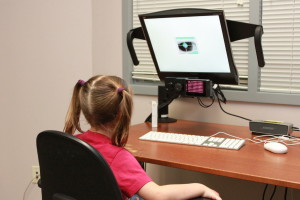The following is exerpted from an article entitled “Experimental Paradigms in Psycholinguistics” by Elsi Kaiser¹:
“… in a visual-world study a participant is normally presented with auditory linguistic stimuli (in a comprehension study), or produces spoken language (in a production study). In comprehension studies, the auditory stimuli are coupled with objects or a visual display – for example in Allopenna, Magnuson and Tanenhaus’s (1998) study on spoken word recognition, people heard instructions like “Clock on the beaker” and saw a computer screen showing a picture of a beaker, a speaker, a beetle, and a baby carriage….The fact that visual-world eye-tracking allows for the linguistic stimuli to be presented auditorily means that it is suitable for investigating issues linked to the acoustic aspects of speech, including different kinds of prosodic cues….as well as phonetic information such as voice onset time (McMurray, Tanenhaus, and Aslin 2002).
Visual-world eye-tracking is well-suited for psycholinguistic work because…people’s eye movements are very closely time-locked to the speech stream. In other words, we tend to automatically look at what we think is being talked about…eye movement patterns can provide a real-time indication of how people interpret auditory input.”

The CCP has three eyetrackers, one desk-mounted and two remote. The remote eyetrackers require only that the participant wear a small sticker on their forehead. The desk-mounted eyetracker has a chin-rest attached to a desk which prevents the participant from moving their head during the experiment.

Eyetrackers track the pupil of the participant and uses infrared light to track their corneal reflection at the same time. The vector between the pupil center and the corneal reflections can be used to calculate the the point on the screen where the participant is looking.
1. Kaiser, E. ((2013). Experimental paradigms in psycholinguistics. In R.J. Podesva & D. Sharma (Eds.), Research methods in linguistics (135-168). Cambridge: Cambridge University Press.
